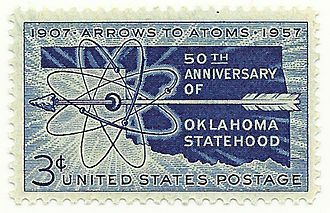
Oklahoma’s compelling history reflects both hardship and resilience, shaped by Indigenous peoples, settlers, and modern-day citizens forging a shared future. Tracing these events—through prehistoric migrations, colonization, forced removals, booming economies, and community rebuilding—deepens our understanding of the state’s collective identity. Researchers, genealogists, and anyone curious about Oklahoma’s heritage can discover abundant local, tribal, state, and federal records that shine a light on the many narratives that define this remarkable region.
Research your ancestors on MyHeritage
Pre-Colonial EraPre-Colonial Era
- Before 10,000 BCE: Paleo-Indian groups, including Clovis and Folsom cultures, inhabit the region. Archaeological sites show evidence of hunting large game such as mammoths and bison.
- c. 500 CE – 1300 CE: Mound-building cultures (Caddoan-speaking peoples) thrive in parts of Oklahoma. Communities establish trade networks across North America.
- 14th–16th Centuries: Wichita and other related tribes inhabit present-day Oklahoma, cultivating crops and establishing village communities along river valleys.
Early European ContactEarly European Contact
- 1541: Spanish explorer Francisco Vázquez de Coronado passes through parts of present-day Oklahoma in search of mythical riches, becoming one of the first Europeans to traverse the area.
- 1682: French explorer Robert Cavelier de La Salle claims the Mississippi River region for France, encompassing large swaths of modern Oklahoma.
- 1700s: French traders and trappers move through the area, exchanging goods with Indigenous tribes. This era witnesses the beginnings of a fur trade network and cultural exchange.
Transition to American InfluenceTransition to American Influence
- 1803: The United States acquires most of present-day Oklahoma through the Louisiana Purchase, marking a significant expansion of U.S. territory west of the Mississippi.
- 1800s (Early): Explorers such as Zebulon Pike and Stephen H. Long chart the region, providing maps and reports that influence future settlement and policy.
19th Century and the Era of Indian Removal19th Century and the Era of Indian Removal
- 1830: The Indian Removal Act is signed by President Andrew Jackson, authorizing the forced relocation of Eastern Native American tribes to lands west of the Mississippi, including present-day Oklahoma.
- 1831–1839: The Trail of Tears—the forced removal of the Cherokee, Choctaw, Chickasaw, Muscogee (Creek), and Seminole peoples—brings thousands to the area, which becomes known as Indian Territory.
- 1840s–1850s: Tribes work to rebuild communities, governments, and school systems in Indian Territory, establishing new identities while retaining traditional lifeways.
- 1861–1865 (Civil War): Native nations within Indian Territory are divided, with some aligning with the Confederacy and others supporting the Union. The war devastates the region and disrupts tribal institutions.
Reconstruction and the Western FrontierReconstruction and the Western Frontier
- 1866: Post-Civil War treaties force tribes to cede additional lands. Freedmen within tribal nations negotiate new statuses in tribal governments.
- 1870s–1880s: Cattle drives from Texas to Kansas pass through “Indian Territory,” spurring economic activity and the establishment of frontier towns.
Land Runs and StatehoodLand Runs and Statehood
- 1887: The Dawes Act (General Allotment Act) begins the process of allotting tribal lands to individual members, opening remaining lands to non-Native settlement.
- April 22, 1889: The first Oklahoma Land Run opens the Unassigned Lands to settlers, resulting in a rush of homesteaders who found cities like Oklahoma City and Guthrie almost overnight.
- 1890: The Organic Act establishes the Oklahoma Territory (separate from Indian Territory), laying a framework for future governance.
- 1891–1895: Additional land runs occur, further opening Indigenous-held lands and rapidly increasing non-Native population.
- 1901: The Kiowa-Comanche-Apache and Wichita-Caddo reservations are opened for settlement, continuing the pattern of land dispossession.
- November 16, 1907: Oklahoma becomes the 46th state, combining the Oklahoma Territory and Indian Territory into a single entity.
Early Statehood and the Oil BoomEarly Statehood and the Oil Boom
- 1900s (Early): Discovery of massive oil reserves in places such as Glenn Pool and Cushing leads to an economic boom, with Tulsa emerging as the “Oil Capital of the World.”
- 1907–1920s: Rapid industrial and population growth. Construction booms bring infrastructure, including railroads and roads.
Social Upheavals and Cultural MilestonesSocial Upheavals and Cultural Milestones
- 1910s–1920s: Racial tensions escalate. Vigilante and Ku Klux Klan activities rise in many communities.
- 1921: Tulsa Race Massacre devastates the prosperous Greenwood District, a predominantly African American neighborhood known as Black Wall Street.[1]
- 1930s (Dust Bowl Era): Severe droughts and dust storms ravage farmlands in western Oklahoma. Many families migrate westward along Route 66 in search of better opportunities.
Mid-20th Century ChangesMid-20th Century Changes
- 1940s: World War II brings the establishment of military bases and manufacturing centers in Oklahoma, spurring jobs and economic growth.
- 1950s–1960s (Civil Rights Movement): Oklahomans participate in national civil rights efforts; desegregation slowly proceeds across schools and public institutions.
- 1960s–1970s: Urbanization intensifies; aerospace and energy industries grow. Tinker Air Force Base and other facilities become major employers.
Late 20th Century DevelopmentsLate 20th Century Developments
- 1970s–1980s: Oil industry crashes in the mid-1980s, causing economic turmoil. Many energy companies reduce operations, and the state looks to diversify its economy.
- 1990s: Renewed interest in tribal sovereignty and economic development. Casinos, tribal businesses, and cultural tourism expand.
- April 19, 1995: Oklahoma City bombing at the Alfred P. Murrah Federal Building becomes the deadliest domestic terrorism incident in U.S. history at that time, prompting national mourning and extensive rebuilding.
21st Century Oklahoma21st Century Oklahoma
- 2000s–2010s: Growth in diverse economic sectors (aerospace, agriculture, energy, biotech). Downtown revitalizations in Oklahoma City and Tulsa bring cultural and social transformation.
References
- ↑ The Attack on Greenwood. Tulsa Historical Society & Museum

